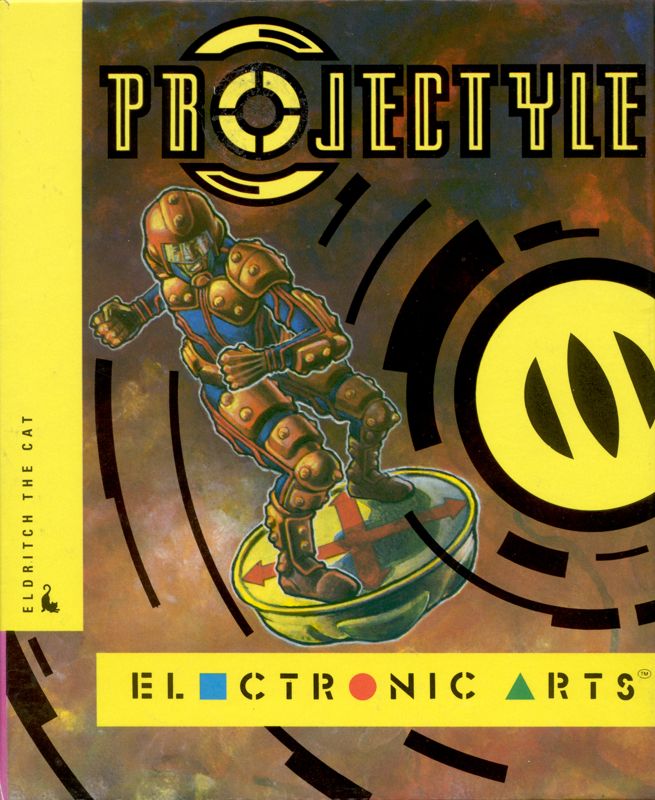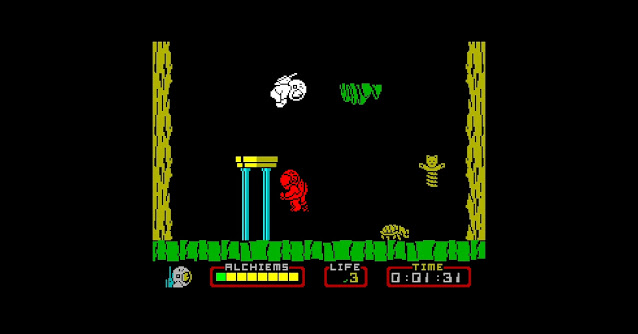Eldritch The Cat Mk II : 1989 - 1990
Part 2 of the Eldritch The Cat story. Part 1 is here, part 3 is here.
During the development of Projectyle, Marc & I wanted to kick off another game to increase our studio's cash flow and fill Marc’s plate after Astaroth was completed. We tried several things, none of which saw the light of day or exist in any shape or form today. It is difficult to recall the exact order of the things we tried, but here goes with an accounting of a few more games that weren't.
 |
| The Projectyle Box |
Heart of Yesod
In short, Heart of Yesod was an attempt to bring some game characters and art styles from the Odin Computer Graphics games into the 16-bit era, with Colin Grunes on art. I've covered this in some detail on this blog here.
Special Eyes
Right around the time Ultimate resurfaced as Rare and started doing press in the popular game magazines, talking about their 'Razz' arcade board, Marc & I figured we’d get in touch with them and pitch them a game. We created some paper design documents and concept art for a game called 'Special Eyes' featuring a range of eyeball-shaped characters, each with a unique look and abilities (walking, flying, etc., etc.); each character was "specialized." It seemed like a good idea at the time, even if it does sound like a high street optician chain, so that is what we went with. I don’t remember the gameplay; it would probably be something sideways scrolling.
 |
| "Mesmerize" Rendering courtesy RunwayML |
Somehow, we got through on the phone, probably by mentioning Odin Computer Graphics, and managed to get a meeting with Chris & Tim Stamper, at their offices near Twycross. Result! Neither Marc nor I had our own transportation at this stage (there's a theme here), and so off we went on a combination of trains, buses & taxis from Liverpool to Twycross.
The Rare office, so-called Manor Farmhouse, had the appearance of an old manse converted to offices, the old quadrangle in the back now used for parking, and were there stables around the back? We had a nice meeting with Chris and Tim, I seem to recall that Chris was more supportive (he would use expressions like, ‘when you get to work on the Razz board’), and Tim came across as more skeptical. We did not get a chance to pitch our game, and they did not want to see any of the artwork we’d prepared. In retrospect, they were protecting their business by approaching things that way; I think we were a little gung-ho. Our interview lasted 30 minutes, and we were graciously given a ride back to the train station. And that was the end of that! Of course, we were disappointed. We hadn't wanted to visit Rare empty-handed, but Special Eyes was probably more form than function and not our best foot forward. Again, with 20/20 hindsight, we'd have been better presenting ourselves rather than a half-baked game idea. I think I was particularly disappointed because the Ultimate games were one of the inspirations for me to get into the industry. Still, at least I could meet two of my heroes!
Champions Eternal
Around this time, I had been enjoying the Michael Moorcock books featuring the Eternal Champion characters Elric of Melniboné, Dorian Hawkmoon, Erekose, and Corum (all incarnations of the same being), and enjoying artist Rodney Matthews's visual renderings of some of these characters. While developing Projectyle, we pitched Electronic Arts on the idea of picking up the license and developing a video game based on the Moorcock characters. EA, particularly our Projectyle producer Kevin Shrapnell and VP of Development Joss Ellis, were interested in exploring this idea. So our people contacted their people, and initial conversations were had (Marc & I were not in those conversations). EA also reached out to Rodney Matthews, and I forget his objections, but unfortunately, he was dead set against the idea of video games.
On the tech side, even though I was supposed to be working on Projectyle, I found myself working on a couple of tech demos that we were trying to figure out how to use in a Champions Eternal game. One was a top-down sprite rendering engine that could also (using affine transformation) rotate sprites around a centroid to give a very smooth rotation of sprites rather than store pre-rotated animation frames. We called this Scrotation for scrolling & rotation. And yes, also because it was childishly amusing.
The other tech I worked on was a 3D fractal landscape generator. Looking back, it is unclear how or if these two pieces of tech would work together or what our overall game design would be.
I recall that, right around this time, Michael Moorcock was to be in a bookstore in Liverpool (at the bottom of London Road, near Lime Street), for a book signing supporting his novel Mother London. Of course, Marc & I went along to the book signing, but I’m sorry to admit that we bottled out of presenting ourselves to him, and I just bought a copy of his book instead, which he did sign. I believe I have that signed copy around here somewhere.
This reminds me of a visit Joss and Kevin made up to my Croxteth Park house to discuss Champions Eternal. Marc & I agreed to meet Joss & Kevin in the car park of the Rocket pub just off the M62 in Childwall, Liverpool. We waited in the car park, and eventually, we saw Joss's car pull in, with Kevin in the passenger seat. At this point, it dawned on us that there may have been a slight miscommunication. Joss was driving a Nissan 240SX, a 2-door and theoretically 4-seater, but practically a 2-seater coupe and Marc & I did not have transportation, having made it to the Rocket on foot (and by bus). Joss & Kevin were expecting to follow us back to my place, but instead, we two 6-foot-something lads ended up somehow sardined into the super cramped back seats of Joss's car for an uncomfortable ride back to Eldritch HQ. We must have looked ridiculous; I don’t know how we got into that car.
And as you’ve probably gathered, dear reader, the Champions Eternal game did not go forward. Not because of the car ride, I think the licensing costs proved too rich, given the size of the 16-bit games market.
 |
| Moorcock's Elric of Melniboné |
Spinning Game, Mark McCubbin, Shadow of the Beast
Also around this time, Marc & I were introduced to a young programmer named Mark McCubbin, who worked at Denton Designs with Stoo Fotheringham et al. Mark had a reputation for being both really fast and able to write highly performant code. He was also seeking a side gig (or had left Dentons, I forget), so we gave him a chance to write a demo for a game idea we had kicking around. Mark came to my house one evening, and we tasked him with writing a routine to rotate the whole Atari ST screen about a midpoint. Over a few hours, Mark set to work, chugging his trademark (at the time) 1-liter bottle of Coke in the process. I am disappointed to report that I don’t remember the outcome of this initial encounter with Mark other than to say no game came out of it. Mark developed the Atari ST port of Shadow of the Beast for Psygnosis, which was ultimately credited to Eldritch The Cat.
We didn’t know it yet, but Mark was to play a big role in the future of Eldritch the Cat.
US Gold
Among many other meetings with publishers, most of which I've forgotten, the meeting Marc and I had with US Gold at their Birmingham office stands out in my memory. We had an appointment with US Gold to discuss work opportunities, so after the usual combination of buses, trains, and so on, we presented ourselves at the US Gold office. We met with two US Gold staff members, Charles Cecil and another character whose name I do not recall. Charles was charming and friendly, but nothing fruitful came of the meeting. Little things sometimes stick in your mind, and I remember the other fellow being very amused at his cleverness when he spotted a mistake on the equipment list we'd provided in our bio. Or maybe he was just amused at my amazing blue and white striped pants. Alas, we'll never know for sure.
Projectyle
Truth be told, our efforts on all of the above did impact the delivery of Projectyle. Projectyle was nominally supposed to be 'my' game (meaning, I'd be the one working on it), but in our failure to secure a second project, Marc and I concluded that we had better buckle down on Projectyle. To that end, Marc implemented the league and player upgrade and customization systems, both of which were basic requirements set out by EA. The rate of progress on Projectyle increased, and soon, we were on the home stretch. I've talked in detail about some of the technical aspects of the Atari ST version of Projectyle, and I intend to get into some details of the Amiga version. I'll include some of that in the next post, but as a brief spoiler, the hardware scroll functionality of the Amiga was not used at all in the Amiga version, which goes some way to explaining why there are no blit waits. :)
 |
| Extract from the WHDLoad Projectyle Notes |
In the next post in the Eldritch The Cat series (which will hopefully take less than 2 years to write), I'll talk about the Mk III version of Eldritch as we expand the size of the team and work with various publishers, some good, some not so much, on such games as Chuck Yaeger's Advanced Flight Trainer, Flimbo's Quest, Last Ninja 3, Myth, and Crime Does Not Pay. I'll talk about some other games that didn't make it despite being signed and despite a lot of effort, such as Tentacle and FLOPS, and I'll touch on some of the game music commissions I took to keep Eldritch afloat.
Until next time ...



Comments